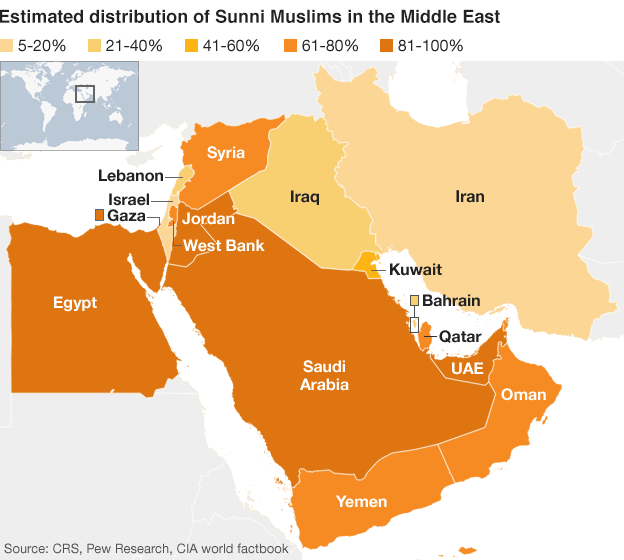Sunnis and Shia: Islam's ancient schism
- Published

Pilgrimage to Mecca is one of many rituals that are shared by both sects
The divide between Sunnis and Shia is the largest and oldest in the history of Islam.
Members of the two sects have co-existed for centuries and share many fundamental beliefs and practices. But they differ in doctrine, ritual, law, theology and religious organisation.
Their leaders also often seem to be in competition. From Lebanon and Syria to Iraq and Pakistan, many recent conflicts have emphasised the sectarian divide, tearing communities apart.

Who are the Sunnis?
The great majority of the world's more than 1.5 billion Muslims are Sunnis - estimates suggest the figure is somewhere between 85% and 90%. In the Middle East, Sunnis make up 90% or more of the populations of Egypt, Jordan and Saudi Arabia.

Egypt is home to some of Sunni Islam's oldest centres of learning
Sunnis regard themselves as the orthodox branch of Islam.
The name "Sunni" is derived from the phrase "Ahl al-Sunnah", or "People of the Tradition". The tradition in this case refers to practices based on what the Prophet Muhammad said, did, agreed to or condemned.

All Muslims are guided by the Sunnah, but Sunnis stress its primacy. Shia are also guided by the wisdom of Muhammad's descendants through his son-in-law and cousin, Ali.
Sunni life is guided by four schools of legal thought, each of which strives to develop practical applications of the Sunnah.

Who are the Shia?
Shia constitute about 10% of all Muslims, and globally their population is estimated at between 154 and 200 million.

The deaths of Ali, Hassan and Hussein gave rise to the Shia concept of martyrdom
Shia Muslims are in the majority in Iran, Iraq, Bahrain, Azerbaijan and, according to some estimates, Yemen. There are also large Shia communities in Afghanistan, India, Kuwait, Lebanon, Pakistan, Qatar, Syria, Turkey, Saudi Arabia and the UAE.
In early Islamic history, the Shia were a movement - literally "Shiat Ali" or the "Party of Ali". They claimed that Ali was the rightful successor to the Prophet Muhammad as leader (imam) of the Muslim community following his death in 632.
Ali was assassinated in 661 after a five-year caliphate that was marred by civil war. His sons, Hassan and Hussein, were denied what they thought was their legitimate right of accession to the caliphate.
Hassan is believed to have been poisoned in 680 by Muawiyah, the first caliph of the Sunni Umayyad dynasty, while Hussein was killed on the battlefield by the Umayyads in 681. These events gave rise to the Shia concept of martyrdom and the rituals of grieving.

There are three main branches of Shia Islam today - the Zaidis, Ismailis and Ithna Asharis (Twelvers or Imamis). The Ithna Asharis are the largest group and believe that Muhammad's religious leadership, spiritual authority and divine guidance were passed on to 12 of his descendants, beginning with Ali, Hassan and Hussein.
The 12th Imam, Muhammad al-Mahdi, is said to have disappeared from a cave below a mosque in 878. Ithna Asharis believe the so-called "awaited imam" did not die and will return at the end of time to restore justice on earth.

What role has sectarianism played in recent crises?
In countries which have been governed by Sunnis, Shia tend to make up the poorest sections of society. They often see themselves as victims of discrimination and oppression. Sunni extremists frequently denounce Shia as heretics who should be killed.

The execution by Saudi Arabia of a prominent Shia cleric triggered a diplomatic crisis with Iran
The Iranian revolution of 1979 launched a radical Shia Islamist agenda that was perceived as a challenge to conservative Sunni regimes, particularly in the Gulf.
Tehran's policy of supporting Shia militias and parties beyond its borders was matched by Sunni-ruled Gulf states, which strengthened their links to Sunni governments and movements elsewhere.
Today, many conflicts in the region have strong sectarian overtones.
In Syria, Iranian troops, Hezbollah fighters and Iranian-backed Shia militiamen have been helping the Shia-led government battle the Sunni-dominated opposition. Sunni jihadist groups, including Islamic State (IS), have meanwhile been targeting Shia and their places of worship in Syria and neighbouring Iraq.
In January 2016, the execution by Saudi Arabia of a prominent Shia cleric who supported mass anti-government protests triggered a diplomatic crisis with Iran and angry demonstrations across the Middle East.
- Published19 December 2013
